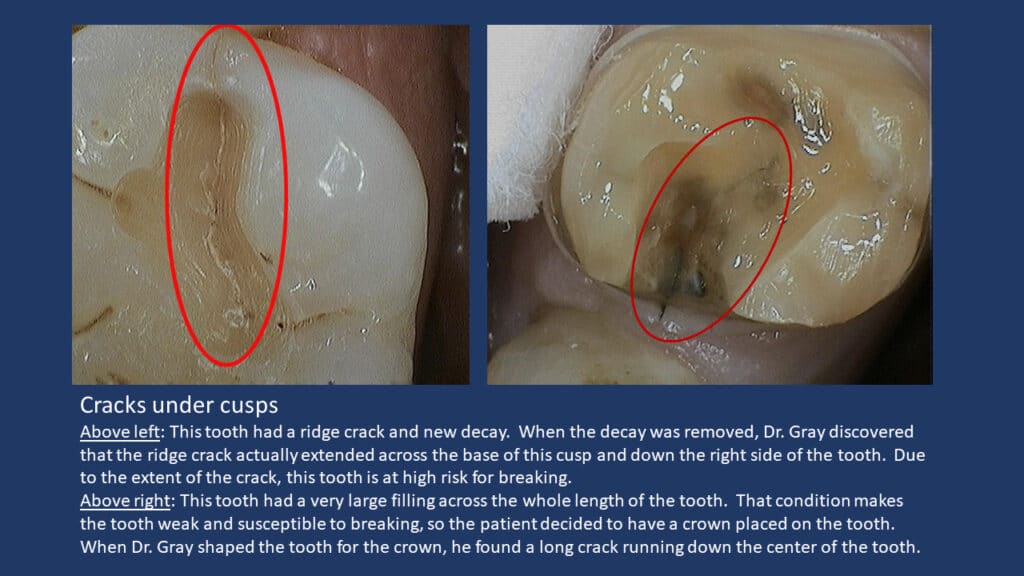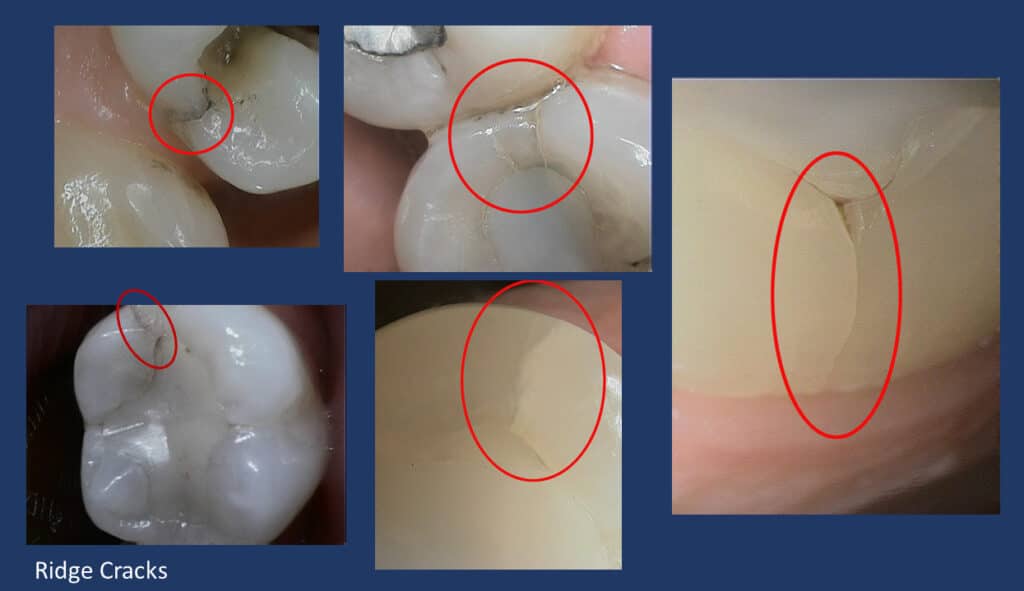Cracked Teeth Services in Fort Collins, CO
A cracked tooth is a common problem—in fact, it is sometimes referred to as a dental epidemic. However, determining whether a tooth is cracked, and the seriousness of the crack, can be tricky.
In the dental field, a cracked tooth is different from a broken tooth. If you’re concerned your tooth may be broken, please visit my broken tooth page.
Symptoms of a cracked tooth may include cold sensitivity, pain with release when chewing, pain when chewing hard foods, or no symptoms at all. Cracked teeth do not tend to hurt when they are pressed on or tapped on. In many cases, cracks are difficult or impossible to see without proper lighting and magnification. Even cracks that are hard to see can be serious problems.


Signs (characteristics that can be found by a dentist) may include a characteristic pattern of bone loss seen on an x-ray, an isolated, very deep pocket next to the tooth, and-or pain when exerting force on specific cusps (points) of a tooth using a dental instrument.
In certain cases, evaluation and 3D imaging by an endodontist (root canal specialist) can be beneficial to provide certainty regarding the presence of a crack or information regarding the extent of a crack.
I examine, evaluate, and treat teeth with cracks all the time at my office. If you think you may have a cracked tooth, or have concerns about whether a crack could cause future problems or is adversely affecting the appearance of your smile, please call for an evaluation.
For a more detailed discussion of diagnosis and treatment for a typical cracked tooth situation, please see my blog post.
Some common types of tooth cracks
Enamel craze lines
You may have noticed vertical white lines on your upper front teeth when looking closely into a mirror. They may remind you of the appearance of a glass window that has a crack running through it but has not broken. Enamel is a mineralized tissue and behaves similarly to glass in many respects. The enamel is supported by dentin, which makes up most of the structure of a tooth. Dentin is also a mineralized tissue, but is more flexible than enamel. Front teeth are long and skinny: picture a long pane of glass glued onto a diving board. The diving board is flexible and the glass is not. As the diving board is flexed, the glass cracks. Similarly (although much less dramatically!), your front teeth flex as you eat, chew, clench, grind, bite your fingernails, etc. As the teeth flex, the enamel cracks. These enamel-level cracks are typically not detrimental to the tooth. They may become stained, or lead to chipping of the chewing edges of the teeth, but rarely cause significant fracture of the teeth.
Ridge cracks
Back teeth have prominent ridges on the front and back ends of the chewing surface. These ridges are a very common site of cracks. These cracks typically form as a result of large fillings, especially if the fillings are metal. Large fillings weaken the tooth, and metal fillings expand and contract with temperature to put additional crack-inducing stress on the tooth. They can also form if the contact points with the opposing teeth put pressure on the wrong part of the tooth. These contacts may be on parts of a tooth that are not designed to accommodate those forces, or they may exert force in a direction that puts sheer force vs compressive force on part of the tooth. In either case, cracks can result.
Root surface cracks
This type of crack extends onto the root surface of a tooth. They usually start as smaller cracks and over time, if the forces that caused them are not relieved, they extend from the part of the tooth you can see in your mouth to the portion of the tooth you can’t see under the gumline and onto the root surface of the tooth. These cracks allow bacteria to penetrate deep below the gumline and infect the area around the root of the tooth.
Cracks under cusps (or points) of a tooth
These cracks tend to form as a result of sideways forces on the points of molars. These sideways forces cause a cantilever-like effect that puts stress at the base of the cusp. A frequently-used bannister loosens at the base over time because sideways forces are exerted at the top and carried down to the base. If the cusp of a tooth is exposed to sideways forces, that force is carried down to the base of the cusp and can develop into a crack. Often, these cracks cannot be seen on the outside of the tooth and are detected by signs and symptoms.
I examine, evaluate, and treat teeth with cracks all the time at my office. If you think you may have a cracked tooth, or have concerns about whether a crack could cause future problems or is adversely affecting the appearance of your smile, please call for an evaluation with Dr. Gray.
For a more detailed discussion of diagnosis and treatment for a typical cracked tooth situation, please see my blog post.
